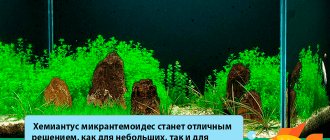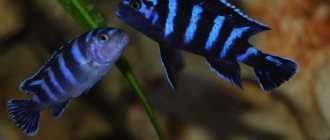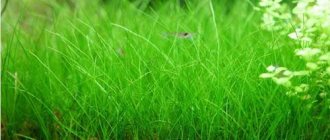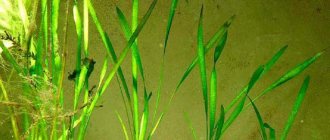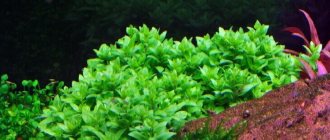4.7
(3)
Some people prefer aquariums in a minimalist style. That is, this is a design with an abundance of decor, stones, lack of living bushes, etc. Others prefer to have an entire underwater garden at home, with a rich variety of plant species and forms. Lovers of natural flora have the opportunity to choose something for their aquarium without much difficulty. There are many varieties of plants. Some are suitable for landing at the back wall, others float in the water column, others stay on the surface, others form a thick carpet at the bottom, etc. There are a lot of options, but one of the most popular is microntemum.
Natural habitat
Micranthemum is classified as a Plantain plant (family Plantaginaceae), although it has nothing in common with the familiar common plantains. It is found in coastal areas of ponds and lakes, swampy areas, slow-moving rivers in tropical and subtropical areas.
The most common perennials in the Antilles grow in the south and north of the United States, the south of Northern Argentina and the territory of Paraguay. Several species of Micrantemum can be found in one area. But all of them are capable of growing on the bottom or surface of water and on land.
Priming
For Micronthemum pauciflora with its fragile root system, you need to use regular sand or aquarium soil with medium-fraction particles. At the same time, the density of the soil is not particularly important for the development of the plant. The main thing is that it has a finely dispersed structure and the roots of the grass easily penetrate into it. The nutritional value of the soil can be increased by adding small lumps of clay. When choosing the right soil, the plant will gain up to 10 cm in length every month.
Return to content
Appearance Features
It is difficult for inexperienced aquarists to distinguish the Micranthemum bush from Hemianthus and Lysimachia, since they are similar in the arrangement and shape of the leaves. Previously they belonged to the Micrantemums, but were later separated because they have leaf blades of different sizes.
Typically, Micrantemum bushes wide . You can recognize the plant by:
- long creeping roots , forming many additional thread-like roots;
- branched stems up to 0.5 cm thick;
- small rounded leaves 1 cm in diameter
- miniature flowers growing 1-2 in the axils of the leaves and blooming in the winter months.
At home, they prefer to breed 3 types of Micrantemum: Monte Carlo, umbrosum and few-flowered.
Micranthemum shady
The shady species grows in the swamps of South and North America. Its main difference is its small leaves, not reaching 1 cm in diameter.
In nature, it grows under and above water up to 20 cm in height and 15 cm in width.
Ideal for artificial tanks of any size, but it looks more harmonious in a tank of 100 liters or more, since in small ones it is more difficult to trim.
The plant is planted in the foreground or middle ground, rooting it by fixing it with a strong synthetic thread between driftwood and stones. But you can just leave it floating on the surface - timid small fish and fry like to hide in its foliage.
Micrantemum gets along well next to ferns and Java moss. With good maintenance and care it grows very luxuriantly and rapidly. The plant needs:
- temperature regime – +21-27°С;
- acidity – from 5.5 to 8 units;
- rigidity – up to 9°;
- solar or fluorescent lighting (power 0.7 W/l) for at least 8 hours;
- silted (but not sour) and loose soil and foliar feeding would be useful;
- the optimal concentration of carbon dioxide (CO2) is from 10 to 15 mg/l, otherwise the leaves will become smaller;
- Regular trimming makes the bushes more voluminous.
Micrantemum will have to be frequently pruned or replanted side shoots. In addition, it is permissible to cut off the tops of the plant and plant them in the ground.
Micrantemum Monte Carlo
Monte Carlo was first discovered in Argentine reservoirs in 2010, in particular near the city of the same name - hence the name. The plant is similar to Hemianthus, but is not its complete analogue: they have completely different sizes of leaf blades (Micrantemum is larger - about 3 mm) and rooting methods (Monte Carlo is fixed more firmly).
The optimal height of Monte Carlo is from 2 to 5 cm.
At the highest height, yellowing of the lower leaves begins, which lack light. It is recommended to plant in the foreground. The plant is perfect for any artificial reservoirs. With it you can create beautiful and varied aquadesign.
This is a relatively new variety for aquarists and little information is available about its contents. However, some nuances are still known:
- the water must be well filtered so that the plant is not covered with algae;
- does not need bright lighting (0.5 watt/l is acceptable);
- for leaves and roots, fertilizing with iron-containing fertilizers is necessary so that the leaves do not turn yellow and fall off (if the leaves become darker and smaller, fertilizing should be stopped for a while and the water should be partially replaced);
- does not require high concentrations of carbon dioxide and minerals;
- It is better to plant Monte Carlo in fine soil;
- temperature indicator of the aquatic environment – from +22 to +28°С;
- hardness – from 5 to 19°;
- acidity – from 5 to 7 units;
- the presence of a weak current in the reservoir is desirable;
- Every week you need to replace the water by a third.
This type of Micrantemum is propagated by cutting long roots or dividing bushes into smaller bunches. Moreover, it is recommended to seat them at short intervals in order to obtain a uniform carpet. If the leaves become smaller and the plant stops growing, it means it does not have enough light. But the appearance of algae suggests the opposite.
Micranthemum pauciflora
Micrantemum pauciflora lives mainly in shallow lakes and ponds of North America, and is especially common in the eastern part. In a species with few flowers, the stems are erect, quite long and branched to the sides. Bushes can grow up to 30 cm.
The light green leaves, arranged in 3-4 whorls, have no petioles at all. The width of the oblong leaf with a blunt apex and wedge-shaped base is 3 mm, and the plate itself is miniature - no more than 1 cm. The roots are very weak, spreading along the ground bottom.
False-flowered is probably the most unpretentious Micrantemum of all species. In order for the plant to grow and develop well, you will need to follow a number of simple rules:
- it is permissible to keep in small aquariums of 20-30 liters, but it is also possible in larger containers;
- acidity – should not exceed 5-9 units;
- rigidity parameters – from 3 to 14°;
- temperature - vary between 16-29°C (hence, the plant will not be damaged even in cool seasons);
- lighting – bright (from 0.7 watt/l), at least 4 hours a day;
- water needs constant filtration and weekly water changes (20% of the total volume);
- fertilizing the soil (blue clay is suitable).
If the conditions of keeping are favorable to the few-flowered Micrantemum, then it grows quickly - it adds up to 10 cm in a month. Since this species spreads along the ground, aquarists often use it for spawning grounds, so that females and males can hide their eggs and hatched fry in dense vegetation. But it is better not to let the growth of Micrantemum take its course, otherwise it will become overgrown with algae, but if this has already happened, you need to change the water.
The low-flowering species reproduces by separating shoots from the root or dividing the stems. Trimming the main stem will lead to the formation of side shoots from the axils of the leaves - they are then planted in a separate place in the aquarium. Young shoots instantly take root and adapt to new conditions.
Bushes grow up to 30 cm.
Due to its fragility, Micrantemum pauciflora is often broken and spoiled by aquarium inhabitants: snails, barbs or cichlids.
Description of the plant
Micrantemum pauciflora has a flexible, branching stem of light green color, which reaches a length of 30 cm. On each leaf node (whorl) of the stem there are 3-4 sessile lanceolate-elliptical leaves 1 cm long and 3-4 mm wide. The distance between the whorls is 1 cm. The grass has thin, poorly developed roots that grow in different directions, acting as an anchor and firmly anchoring the plant in the ground.
INTERESTING: With proper care, hemianthus releases small silvery oxygen bubbles that flicker subduedly in the branched stems and leaves of the plant. Due to this feature, it is called “pearl grass”.
Return to content
Actions before and after purchase
Before purchasing Micrantemum, you should carefully examine it from all sides and make sure that there are no algae on the leaves (they can grow throughout the aquarium and damage all the vegetation). If algae is found already at home, the plant must be thoroughly washed.
Each bush is planted in a pre-allocated place, but if the bush turns out to be larger than expected, it can be divided into several parts and planted in another place or simply allowed to float on the surface - there is no need to root it.
Before rooting a young plant, it is recommended to first place a small piece of clay or suitable fertilizer in the hole. A place for Micrantemum must be chosen that is well lit; therefore, the background will definitely not be suitable; the best option is the foreground. Natural light or fluorescent lamps are suitable for lighting.
The plant will grow quickly. You can allow it to occupy the entire bottom to create a beautiful green carpet, or promptly remove it from inappropriate places. But even in the case of a carpet, trimming will be required, because it also grows in height and over time will lose its effectiveness and decorativeness if this is not done. Bushes planted between stones or fixed on snags look best.
Aquadesign
The aquarium plant Hemianthus micranthemoides is suitable for back, middle and foreground landscaping in aquariums of any size. In large aquariums it is used as a background plant, allowing the shoots to grow freely and send out lateral shoots. In the foreground and middle ground, this grass is used to place accents in the composition, as well as to create a dense green carpet that partially or completely covers the ground.
INTERESTING: For its ability to fit organically into aquariums of any size, aquarists have nicknamed hemianthus “the king of aquarium arrangement”
Return to content
Conditions of detention
Mikrantemum gets along in aquariums of any size, but the most optimal size is from 70 liters and more; trimming the underwater “lawn” in them is more convenient and easier. In small (20 liter) aquariums it can choke out other plants. In addition, the plant looks more interesting and organic in large containers, without disturbing other inhabitants of the plant and animal world of the aquarium. Compared to other types of aquarium plants, Micrantemum is unpretentious and quickly adapts.
It develops and grows more actively in warm (25-28°), not hard (6°), not acidic (6-7 units) waters.
To enhance the brightness of foliage and its density, it is not direct, but diffused light that is favorable, and whether it is artificial or natural does not matter. A high concentration of carbon dioxide (CO2) is also important, but this is not important for all Micrantemums.
If new leaves do not grow or have become small, perhaps the parameters are seriously violated and you need to double-check each indicator and act accordingly: the temperature has dropped - increase, the water has become too acidic - reduce the indicators, etc. If everything is normal, after a partial change of water the problems will solve themselves.
Unfortunately, there is not as much information about Micrantemum as we would like, and aquarists have to cope with most of the problems that arise in their maintenance on their own, by trial and error. But there are still general conditions for growing Micrantemum at home:
- Natives of swamps need sufficient lighting: if there is little light, the plant becomes elongated, the leaves become smaller or growth stops completely.
- Each species has long roots, so it is better to plant them in light, fine-grained soil.
- For active and lush growth, fertilizing with some kind of fertilizer complex is required; if there is a deficiency, the leaves turn yellow and fade.
- Regular filtration and systematic partial changes of water have a positive effect on the development of Micrantemum. If you ignore this point, the leaf blades will quickly become covered with a layer of algae, the former beauty will be lost or the plant will die.
- You need to monitor the water parameters: at a pH above 8, the leaves dissolve.
- When CO2 concentration is added, the plant turns into a bright green mat.
If you trim the plant regularly and monitor the density of plantings, it will look fascinating.
Possible difficulties
If the plant has stopped growing, then a possible reason may be a change in conditions. It is necessary to observe the Micrantemum - most likely, in a few days new foliage will begin to appear again.
Leaf damage can be caused by both algae and herbivorous fish.
In order to prevent the appearance of algae, a number of usual measures are carried out: regularly replacing part of the water volume, providing diffused lighting, etc. The problem of fish is also solved quite simply: you should initially understand that Micrantemum plantings are incompatible with herbivorous species. Editorial team LePlants.ru
Diseases and pests
For Micrantemum, as a rather fragile plant, everything is dangerous: algae, snails and herbivorous fish. Growing algae can damage the leaves and gradually destroy the entire bush. To prevent this from happening, you need to change the water more often and not make the lighting too bright. In any case, you need to observe and adjust the parameters. If something goes wrong, change them and observe again.
If barbs, snails and cichlids are being picked off in an aquarium, it is better not to plant Micrantemum there, but to allocate a separate tank for the plant with non-herbivorous inhabitants.
Reproduction
Micrantemum reproduces easily: by roots, shoots or cut tops, planted right there in the ground. Be sure to put fertilizer or clay under the beginner. This is extremely necessary for the new plant to take root and take root faster. But even without additional nutrients, the crop takes root safely.
This type of aquarium culture was discovered not so long ago, but has already taken an honorable place in the list of herbaceous ornamental plants intended for aquariums. Micrantemum fascinates with its unique appearance and elegance, rapid growth, and resistance to trimming. It is wrong to say that plants are very easy to care for, but once you understand the water parameters and filter settings, it becomes easier.
Among all above- and underwater crops, aquarists especially highlight Micrantemum for its unpretentiousness, beauty and easier living conditions. All its species are easy to care for, and with a little effort, you can turn an ordinary aquarium into a fabulous underwater world with amazing herbal figurines. And how interesting the plant looks on stones and snags! Some aquarists even organize competitions for the design of the underwater kingdom.
Immediate family
Hemianthus micranthemoides is often confused with its closest relative, Hemianthus cuba. These plants have much in common, but there are also significant differences between them, listed in the following table.
| The main differences between pearl grass and hemianthus cubes | ||
| Sign | pearl grass | Hemianthus cuba |
| Number of leaves in a whorl, pcs. | 3-4 | 2 |
| Leaf Shape | Lanceolate-elliptical, with pointed ends | Oval, with rounded ends |
| Leaf color | Light green | Dark green |
| Length of internode, cm | 1 | 0,1-0,3 |
| Growth rate | High | Average |
| Growth method | Grows due to lateral shoots | Grows through creeping roots |
| Plant height | Up to 30 cm | Up to 3-6 cm |
| Hat shape | Lush, tall, with many side shoots | Low, dense, follows the curves of the relief |
| Content complexity | Low | Average |
Return to content
